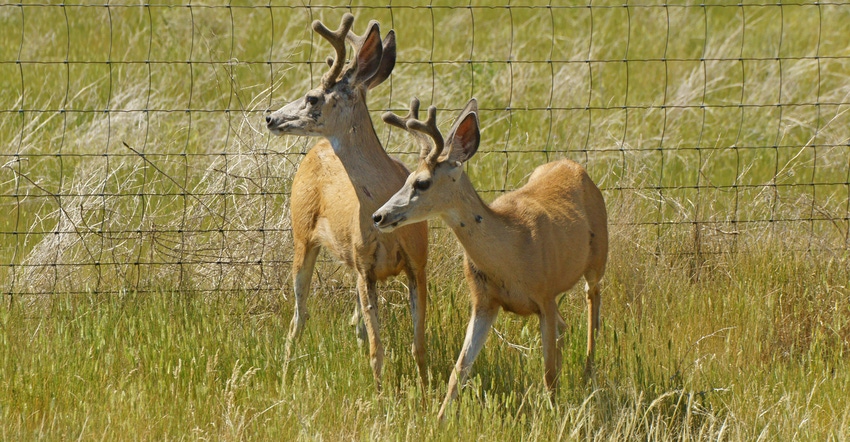
State efforts to get a handle on chronic wasting disease in Minnesota is frustrating lawmakers and residents alike.
During a two-hour virtual meeting Sept. 14, the House Environment and Natural Resources Finance and Policy committee heard public testimony and received an update on the latest research done by the Minnesota Center for Prion Research and Outreach (MNPRO) at the University of Minnesota.
Deer hunting and tribal organizations asked that the state place a moratorium on new cervid farms and buy out existing farms to shut down the industry.
According to the Minnesota Department of Natural Resources, deer hunting generates nearly $500 million annually in total economic activity in the state.
The first CWD-positive farmed cervid — an elk — was identified in 2002 in Aitkin County. The first CWD-positive wild deer was found in 2010 in Olmstead County, 2 miles from a CWD-positive elk farm that was identified the year prior. Since then, 115 CWD-positive wild white-tailed deer have been found in Fillmore, Winona, Houston, Dakota, Olmsted and Crow Wing counties. Twelve 12 CWD-positive cervid farms have been identified, the latest in Beltrami County.
In response to the spreading disease, the DNR created and operates under a CWD response plan, last updated in 2018, and established management zones in northern, central and southeastern Minnesota to curtail CWD. And because of recent legislation, both the Minnesota Board of Animal Health and the DNR possess concurrent authority to regulate farmed white-tailed deer.
MNPRO co-director Peter Larsen told the committee about that work done with a highly sensitive prion detection assay known as RT-QuIC. The MNPRO research team was the first to test for CWD in the field, which they used in March. The RT-QuIC can detect CWD prions in samples that traditional samples cannot — decomposing animal tissues, blood and feces, as well as soil, water, plants and insects.
In May, the MNPRO team secured a Beltrami County carcass dump site that was associated with a nearby cervid farm found in April to have a CWD-positive doe. Larsen said the dump site, about a half-mile from the farm, was used by the farmer. The team tested bones, soil and plants for CWD from the dump site and initially found CWD-positive bones. Since carcasses were spread across roughly 10 acres by scavengers, the researchers could not determine the number or age of deer dumped. Since the farmed herd was deemed CWD-positive, it was depopulated — 13 total CWD-positive deer and fawns on the farm.
Since June, the DNR erected a fence around the carcass dump site, costing $194,000, to contain roughly 15 acres. Further testing with RT-QuIC by MNPRO researchers of recovered remains showed CWD-positive bone, insect, nervous tissue, bone marrow, maggots and soil samples.
On the Beltrami County cervid farm itself, additional deer remains were recovered during depopulation and tested with RT-QuIC. Those, too, tested CWD-positive, bringing the total number of CWD-positive animals on the deer farm to at least 19.
Larsen expressed concern with CWD found in the soil. MNRPO had another lab confirm that finding.
“CWD prions can remain in soil for years,” he says. “This was concerning because there were no bones on the site where soil samples were taken. The soil cores were positive for CWD prions, so that suggest environmental contamination.”
MBAH and DNR officials also gave reports. A report by DNR wildlife health group leader Michelle Carstensen included monitoring and surveillance efforts and carcass disposal programs, as well as what to expect for the 2021 deer hunting season. Carstensen also stressed that CWD prevalence in the wild deer population is low. In Fillmore County, for example, CWD in wild deer is less than 5%, she says.
“It is a persistent but rare disease in Minnesota, and we want to keep it rare,” she adds. She cautioned lawmakers from reacting too quickly to establish stricter regulations for hunters before they are needed.
Beth Thompson, MBAH executive director, discussed specifics pertaining to the Beltrami County deer farm and traceback efforts of animal movements to Hennepin, Winona and Kanabec County source farms.
Groups want cervid farms banned
The incident in Beltrami County has upset many who hunt and are concerned about wild deer conservation and health.
Representatives from the CWD Action Coalition, tribal organizations, Backcountry Hunters & Anglers and the Minnesota Conservation Federation all called for a moratorium on new cervid farms, and for buyout and closure of existing cervid farms.
Matt Lee, chair of Backcountry Hunters & Anglers, noted that it’s been 20 years since the state has been dealing with CWD.
“We support a moratorium and a shutdown of current operations if we can’t come up with an executable [management] plan,” he says. He pointed to the economic benefits of the two industries, noting that cervid farming pales in comparison to wild deer hunting.
“Deer hunting in Minnesota generates $500 million a year, while $25 million [2016 data] was generated by the cervid industry,” Lee says. “That’s 20 times more money spent by Minnesota hunters than anything involved with cervid farming in this state.”
State House committee member Rep. Jamie Becker-Finn (DFL-Roseville) questioned fall hunting rules that regulate deer waste disposal. As a hunter and a mom, she noted that travel distance to disposal sites and a two-week time lag for CWD testing results was not feasible.
“This isn’t going to work. We need to try harder,” she says. “It isn’t responsible to ask someone to butcher something with their bare hands and then wait two weeks and then depending on the test, having to drive and dump it.”
Two St. Louis County commissioners also spoke at the meeting. They announced that the county board recently approved a moratorium on new cervid farms and on animal movement.
“The straw that broke the camel’s back was what happened in Beltrami County,” says Patrick Boyle, county commissioner. “We have to start a domino effect with other counties — no new cervid farms and no movement of deer among [existing] cervid farms.”
Keith Nelson, county commissioner, who identified himself as a 40-plus-year hunter and a beef farmer, says he is very concerned about movement of animals exposed to CWD.
“St. Louis County is the largest county in Minnesota, and with the largest amount of public land,” he says. “That exposure to our wild herd is a concern. … It is absolutely imperative that the DNR and BAH work together.”
Nelson also notes the disparity of how farm animal disease outbreaks have been handled in the state.
“If this was a case of Johne’s [disease] in a beef herd, the action would be swift,” he says. “But CWD on a deer farm doesn’t seem to bring the same level of concern, and I don’t understand it. I hope the moratorium is something that can be supported statewide.”
Editor’s note: Watch or listen to the meeting via this link: Minnesota House of Representatives (state.mn.us) Audio and Video Archives. When you click on “Meeting details,” a drop-down menu will give you access to copies of testimonies provided.
About the Author(s)
You May Also Like






